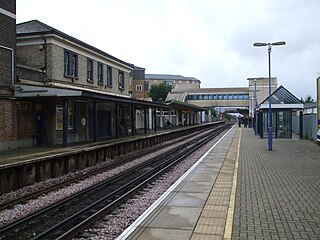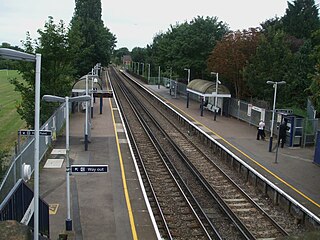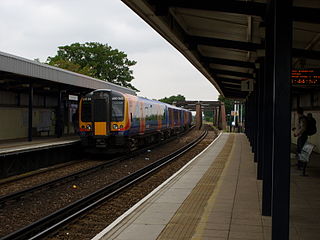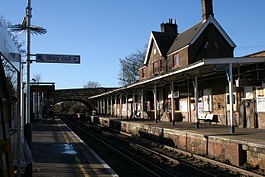
Clapham Junction is a major railway station near St John's Hill in south-west Battersea in the London Borough of Wandsworth, England, 2 miles 57 chains from London Victoria and 3 miles 74 chains from London Waterloo. Despite its name, Clapham Junction is not in Clapham, a district 1 mile (1.6 km) to the south-east.

Vauxhall is a National Rail, London Underground and London Buses interchange station in central London. It is at the Vauxhall Cross road junction opposite the southern approach to Vauxhall Bridge over the River Thames in the district of Vauxhall. The mainline station is run by the South Western Railway and is the first stop on the South West Main Line from London Waterloo towards Clapham Junction and the south-west. The Underground station is on the Victoria line and the station is close to St George Wharf Pier for river services.

Queenstown Road is a railway station in inner south-west London, 2 miles 50 chains (4.2 km) south-west of London Waterloo, between Vauxhall and Clapham Junction. It is a short walk from Battersea Park station and Battersea Park to the west. It has three platforms, two of which are in use by all stopping services related to the Waterloo to Reading Line: its branch services to Weybridge and two separate sets of bidirectional Waterloo-to-Waterloo services via Hounslow using the Hounslow Loop and via Kingston using the Kingston Loop. In addition, 50% of maximum peak hour trains serving the Shepperton branch line call at the station.

Feltham railway station serves Feltham in the London Borough of Hounslow, west London. It was opened on 22 August 1848 by the Windsor, Staines and South Western Railway.

Wandsworth Town railway station is in the London Borough of Wandsworth, in south London, in Travelcard Zone 2. It is 4 miles 60 chains (7.6 km) down the line from London Waterloo.

Barnes railway station is a Grade II listed station in the London Borough of Richmond upon Thames, in southwest London, and is in Travelcard Zone 3. It is 7 miles 7 chains (11.4 km) down the line from London Waterloo. The station and all trains serving it are operated by South Western Railway.

Whitton railway station is in the London Borough of Richmond upon Thames in southwest London, within Travelcard Zone 5. It is 12 miles 43 chains (20.2 km) down the line from London Waterloo. The station and all trains serving it are operated by South Western Railway. The station was extensively refurbished and its main buildings replaced 2015–2016. The footbridge was replaced so as to incorporate optional lifts to the platforms. Whitton station has a ticket office above the up (London-bound) platform containing a coffee shop, a taxi office, ticket machines and a disabled toilet. The station, to allow periods of no staff, lacks ticket barriers. The operator has had call at the station on most weekdays since 2014 air-conditioned, ten-coach trains. The platforms were extended away from the building and footbridge in February 2012.

Isleworth railway station is located in the London Borough of Hounslow, in west London, and is in Travelcard Zone 4. It is 19 km (12 mi) west-southwest of London Waterloo. The unmanned station and all trains serving it are operated by South Western Railway.

Syon Lane railway station in Travelcard Zone 4 is on the Hounslow Loop Line and borders the Spring Grove and New Brentford neighbourhoods of the London Borough of Hounslow in west London. The office and light industrial zone to the north-east, the West Cross Centre, has among other businesses the headquarters and studios of broadcaster and entertainment multinational company Sky. The station and all trains serving it are operated by South Western Railway.

Brentford is a railway station in the town of Brentford, in Hounslow, London. It is on the Hounslow Loop Line and in Travelcard Zone 4. The station and all trains serving it are operated by South Western Railway. It was the main station for Brentford F.C.'s former ground Griffin Park, 400 metres east. The modest High Street of the suburb of Brentford is 300 metres south-east.

Kew Bridge railway station is a railway station in Brentford, the London Borough of Hounslow, and is in Travelcard Zone 3. The station and all trains serving it are operated by South Western Railway. The station was named after the nearby Kew Bridge.

Chiswick railway station is a railway station within the Grove Park residential area of Chiswick in the London Borough of Hounslow. The station is on the Hounslow Loop Line, and all trains serving it are operated by South Western Railway. Journey time into London Waterloo is approximately 25 minutes and Clapham Junction 15 minutes. The station is in Travelcard Zone 3.

Barnes Bridge railway station, in Travelcard Zone 3, is on The Terrace, Barnes in the London Borough of Richmond upon Thames, in south west London. The station and all trains serving it are operated by South Western Railway. It is on the Hounslow Loop Line, 12 km south west of London Waterloo.

Strawberry Hill railway station is in Strawberry Hill in the London Borough of Richmond upon Thames in south west London, and is in Travelcard Zone 5. It is 12 miles 22 chains (19.8 km) down the line from London Waterloo. The station, and all trains serving it, are operated by South Western Railway. The station is equipped with Oyster card swipe terminals.

Virginia Water railway station serves the village of Virginia Water, in Surrey, England. It is 23 miles 15 chains (37.3 km) down the line from London Waterloo. The station, and all trains serving it, are operated by South Western Railway.

The Hounslow Loop line is a railway line in southwest London which was opened by the London and South Western Railway in 1850. It leaves the Waterloo–Reading line at Barnes Junction and after some seven and a half miles rejoins it at a triangular junction between Whitton and Feltham. Barnes Railway Bridge carries the line over the River Thames. Passenger services, all operated by South Western Railway, either loop back to Waterloo by the junctions or continue southwest via Feltham. The line is electrified at 750 V DC. It provides access to the North London Line for freight services both passing through Clapham Junction to the north east and connecting to the rail network to the south west.

Ashford railway station serves the town of Ashford, Surrey, in the borough of Spelthorne in South East England. It is 17 miles 40 chains (28.2 km) down the line from London Waterloo.

Staines railway station is on the Waterloo to Reading line and is the junction station for the diverging Windsor line, in southern England to the west of London. It is 19 miles 2 chains (30.6 km) down the line from London Waterloo. It serves the town of Staines-upon-Thames in Surrey, England.

Egham railway station serves the town of Egham in Surrey, England. The station is owned by Network Rail and managed by South Western Railway, which also provides the train services. The station is on the Waterloo to Reading line, 21 miles 2 chains (33.8 km) from London Waterloo, between Virginia Water and Staines. The station is also served by trains to Weybridge.

South Western Railway is a British train operating company owned by FirstGroup (70%) and MTR Corporation (30%) that operates the South Western franchise.





















